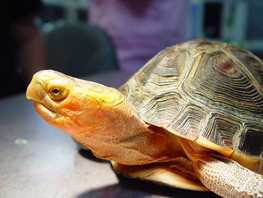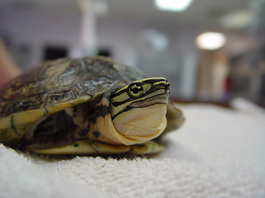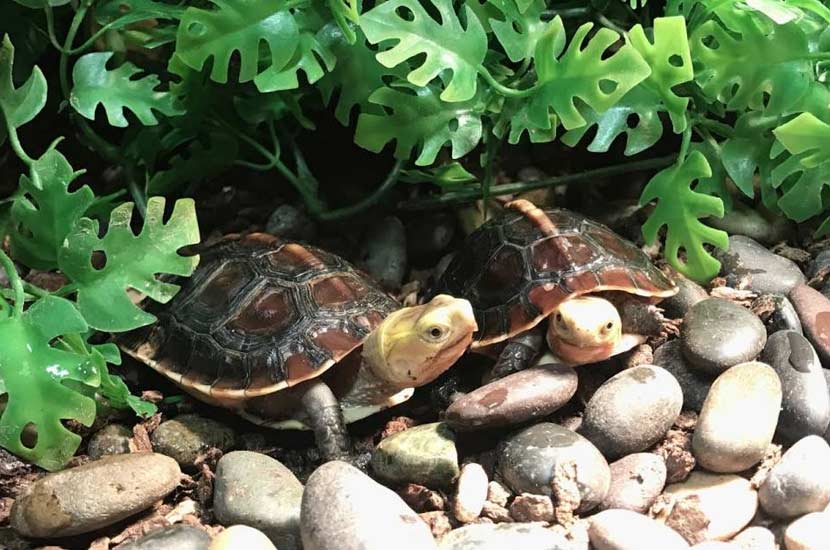Natural History

These inquisitive little chelonians, also called “snake eating turtles”, Yellow Margined box turtles, and Golden-headed box turtles. These turtles are native to the sub-tropical and temperate climates of China, Taiwan, and Japan and have a unique hinge on their plastron that allows box turtles to withdraw their arms, legs, and head fully into their shells and seal up like a box. These animals can stay in this position for hours. These turtles reach a shell size of 5-12 inches long.
In the pet industry, most of these turtles are from Taiwan where they are used for food and folk medicine. With a life span of roughly 25-40 years, these intelligent turtles often become cherished family and sometimes generational pets.
In 1975, the United States government banned the sale of any chelonian with a carapace less than four inches long in hopes of preventing the spread of Salmonella and the destruction of native species in the wild. Domestically bred box turtles are always recommended over their wild caught counterparts.
Enclosure
The larger the enclosure the better! Hatchlings and small juveniles can be kept in glass 20 gallon aquariums but will outgrow them and will spend a significant amount of time trying to “walk through” the glass. Aquariums for adults must be large not only to offer the appropriate space needed for daily exercise and enrichment via foraging behaviors but also to allow for better air circulation. A 40-gallon aquarium or larger is suitable for adults. Building custom enclosures is a viable option and has become quite popular. 4 feet wide by 4 feet long and 12 inch high enclosures are used to house two (female and female or male and female) box turtles comfortably. Since these animals are semi-aquatic, 25-50% of the cage should be a shallow water area. At the very least, a large container for swimming that the box turtle can easily enter and exit for swimming is required.
Rubbermaid containers and under the bed storage boxes are extremely popular options for housing turtles of all ages. An adult boxie can be comfortably kept in a 50-gallon Rubbermaid container or concrete mixing container. The large open tops allow for better air circulation and the rounded corners prevent escapes and make for easier cleaning. These containers are easy to clean and inexpensive to buy and can be modified to suit the tortoise’s needs. Air circulation can be improved further by cutting square or rectangular pieces from the sides and placing screening over the holes. If this method is used it is recommended to place the screening on the outside of the container to prevent sharp edges from potentially coming into contact with the tortoise. Outdoor accommodations should have a small pond of water for swimming and wading as well as an enclosed shelter. Outdoor enclosures must be predator and dig proof.
Cage Accessories
There should be two hide boxes available for box turtles. One should ideally be placed on the cooler side of the enclosure as well as one on the warmer side. Boxies appreciate hiding places especially for their daily naps. Hide boxes can be created from cork bark half logs, half terracotta plant pots, large PVC pipes, and wooden huts. It is necessary that the turtle be able to turn itself around in the hide area.
Rocks, drift wood, and plants (potted or fake) not only make an enclosure aesthetically pleasing to the owner, it also offers enrichment and stimulation to the box turtle. Cage accessories should be changed every week during cleaning to allow the box turtle to explore a new surrounding which not only stimulates their minds and feed a natural behavior but also gives them a reason to exercise. Live plants should be potted to prevent up rooting and destruction of the plants.
Temperature
Box turtles thrive when their enclosures are kept between 80 and 85 °F during the day and with a basking site of 86-95 °F. Day time temperatures can be maintained with basking lights, under tank heaters, heat cable, and/or heat tape. Basking lights are essential to normal thermoregulation behaviors. All under tank heaters, heat tape, and heat cables should be regulated with a thermostat to prevent injuries such as burns. It is strongly recommended all heating implements be attached to the outside of an enclosure. During the night, the temperature can drop as low as 75°F but we recommend no lower than 80°F. The night time temperature should be maintained with a ceramic heat emitter or an under tank heater if needed.
Humidity
These turtles do well in 60-80% humidity. A dig box of dirt can be offered and used to maintain a higher humidity area around 70% which allows the box turtle to regulate its own requirements. The moist dig box simulates the burrows box turtles inhabit when humidity needs to be increased.
Lighting

Box turtles, like all reptilian herbivores, require daily exposure to UVB lighting. A 5.0 ReptiSun bulb helps prevent and correct calcium deficiency issues by simulating the effects of natural sun light. UVB lights should be on for the duration of the day light cycle which should be roughly 12 hours a day. All UVB bulbs must be no more than 18-24 inches away from the box turtle directly over head and no closer than 12 inches. The bulb should be replaced every 6-12 months even if it still working to insure that the proper amount of UVB radiation is being produced.
No lighting is needed at night and is actually contraindicated. Box turtles are capable of seeing color as well as some infrared light. The use of black lights, red lights, and blue lights although marketed for reptiles can be stressful to some boxies and should be avoided. If extra heat is needed, an under tank heater or a ceramic heat emitter can be used as they have no light source.
Substrate
Reptile carpet or indoor/outdoor carpet with timothy hay on top is a great substrate for box turtles. The timothy hay offers enrichment, foraging, and a little extra toe exercise as a box turtle maneuvers over the textured terrain. The carpet underneath is an excellent barrier between the boxie and the enclosure floor, especially when under tank heaters are utilized. Other substrates to consider are newspaper/newsprint, paper towel, butcher paper, and alfalfa pellets especially in younger box turtles to monitor defecation.
Box turtles are known diggers and a “dig box” of just top soil with no additives should be provided to all boxies. Great care must be taken that the substrate in the box is kept clean and changed weekly to prevent mold and excessive bacterial growth. These boxes of dirt fulfill a natural need for the box turtle while maintaining humidity in the cage. The substrate should always be moist enough to clump together but not moist enough that excess water drains out when pressed together in an owner’s hands.
Spot cleaning of feces and uneaten food should be done daily as needed and a full substrate change done every week or as needed.
Diet
Box turtles are omnivores that lean more towards the carnivorous and insectivorous side of the spectrum. A stable diet of 50% animal protein or high protein foods, 40% vegetables and leafy greens, and 10% fruit is recommended. Chinese box turtles do not relish large amounts of leafy greens but will readily eat other shredded vegetables. Earthworms are an excellent source of animal protein and should be offered at every feeding. Roaches, crickets, slugs, snails and meal worms can also be offered and provide enrichment for these turtles. However, these natural carrion eaters will relish small amounts of cooked chicken as well as beef heart once a week.
Vegetables should primarily focus on calcium rich greens and beta-carotene rich foods. Avoid feeding broccoli, spinach, and kale in large quantities as these foods cause significant gastrointestinal and urinary issues including stones. Avoid feeding dog or cat food as the excessively high protein levels can cause severe kidney problems. It helps to remember that box turtles are naturally attracted to flowers, red foods, orange foods, and yellow foods.
Juveniles should ideally be fed every day while adults should be fed every other. A calcium supplement should be used 2-3 times a week and a multi-vitamin once a week to help balance the diet. Box turtles should be fed during the day and misted prior to eating to stimulate a feeding response. For finicky eaters, finely chopped salads and even pureed salads will help to train these turtles to eat properly.

